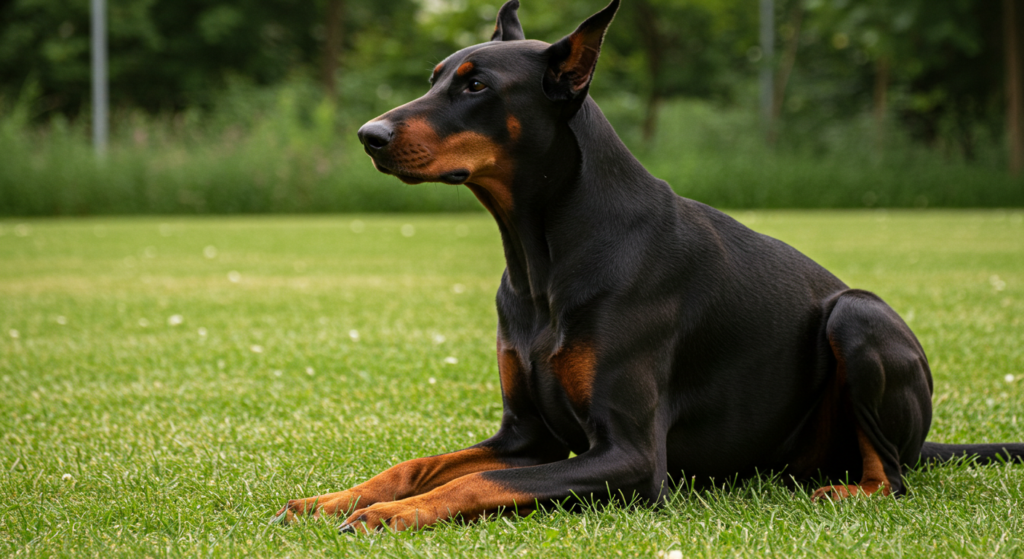Table of Contents
- Introduction
- History of the Dobermann
- Physical Characteristics
- Temperament and Personality
- Training and Exercise Needs
- Health and Lifespan
- Grooming and Care
- Is a Dobermann Right for You?
- Conclusion
- FAQs
Introduction
The Dobermann (also spelled Doberman Pinscher) is a powerful, intelligent, and loyal dog breed known for its sleek appearance and protective nature. Originally bred as guard dogs, Dobermanns are now popular as family companions, police dogs, and service animals. This guide explores their history, traits, care requirements, and suitability for different households.

History of the Dobermann
The Dobermann was developed in Germany during the late 19th century by Karl Friedrich Louis Dobermann, a tax collector who wanted a fearless guard dog. The breed likely descended from mixes of Rottweilers, German Pinschers, Greyhounds, and Weimaraners. Over time, they became prized for their intelligence, agility, and loyalty.
Physical Characteristics
Dobermanns are medium-to-large-sized dogs with a muscular, athletic build. Key features include:
- Height: 24–28 inches (males), 22–26 inches (females)
- Weight: 75–100 lbs (males), 60–90 lbs (females)
- Coat: Short, sleek, and low-maintenance
- Colors: Black, red, blue, or fawn with rust markings
- Ears & Tail: Traditionally cropped and docked (now banned in some countries)
Temperament and Personality
Despite their intimidating appearance, Dobermanns are:
- Loyal & Protective – Excellent guard dogs but affectionate with family.
- Intelligent & Trainable – Rank among the top 5 smartest dog breeds.
- Energetic & Playful – Require mental and physical stimulation.
- Good with Families – Can be gentle with children if socialized early.
Training and Exercise Needs
- Obedience Training: Essential due to their strength and intelligence.
- Socialization: Prevents aggression toward strangers or other animals.
- Exercise Requirements: At least 1–2 hours of daily activity (walks, runs, agility training).
Health and Lifespan
Dobermanns live 10–13 years but are prone to certain health issues:
- Dilated Cardiomyopathy (DCM) – A common heart condition.
- Hip Dysplasia – Joint problem affecting mobility.
- Von Willebrand’s Disease – A bleeding disorder.
Regular vet check-ups and a high-quality diet help maintain their health.
Grooming and Care
- Coat Care: Weekly brushing to reduce shedding.
- Nail Trimming: Monthly to prevent overgrowth.
- Dental Hygiene: Brush teeth 2–3 times a week.
Is a Dobermann Right for You?
This breed suits:
✔ Active owners who can provide exercise and training.
✔ Experienced dog handlers (not ideal for first-time owners).
✔ Families with space (apartment living is possible but challenging).
Conclusion
The Dobermann is a loyal, intelligent, and protective breed that thrives with proper training and care. While they require an experienced owner, their devotion and versatility make them outstanding companions.

FAQs
1. Are Dobermanns aggressive?
No, they are naturally protective but not aggressive if properly trained and socialized.
2. Do Dobermanns shed a lot?
They have a short coat and shed moderately; weekly brushing helps.
3. Can Dobermanns live in apartments?
Yes, but they need ample exercise and mental stimulation.
4. Are Dobermanns good with kids?
Yes, when raised with children, they are gentle and protective.
5. Why do some Dobermanns have cropped ears?
Historically for aesthetics and function, but many countries now ban the practice.
